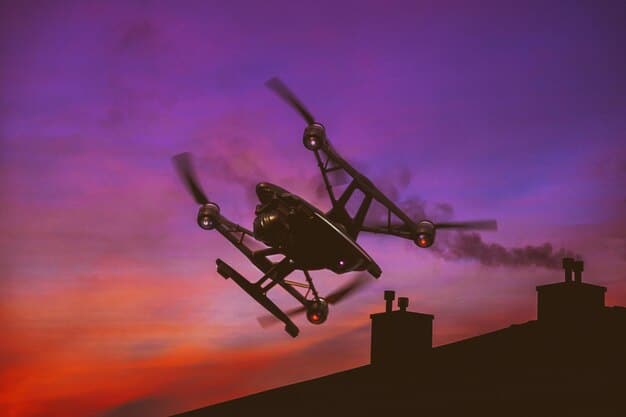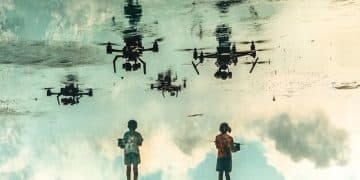US Military’s New UAP Protocol: Transparency & Data Strategy

The US military has significantly updated its protocols for handling Unidentified Aerial Phenomena (UAPs), emphasizing standardized reporting, enhanced data collection, and a commitment to transparency while maintaining national security.
The landscape of reporting and investigating Unidentified Aerial Phenomena (UAPs) within the United States military has undergone a significant transformation. Historically shrouded in secrecy and often dismissed, the approach to these enigmatic aerial observations has shifted dramatically, driven by national security concerns and a growing demand for transparency. This evolution reflects a pragmatic understanding that unexplained aerial incidents, regardless of their origin, pose potential risks to military operations and aviation safety. The US Military’s Updated Protocol for Handling Unidentified Aerial Phenomena (UAPs) marks a pivotal moment, signaling a structured, serious, and scientific engagement with a phenomenon once relegated to the fringes.
The Paradigm Shift: From Secrecy to Scrutiny
For decades, the topic of UAPs, more commonly known as UFOs, was largely met with skepticism and often ridicule within official circles. Military personnel who reported unusual sightings faced dismissive responses, or even professional repercussions. This culture of silence led to a significant underreporting of incidents and a lack of systematic data collection.
However, recent years have witnessed a profound shift. Congressional interest, coupled with compelling eyewitness accounts and undeniable sensor data, has compelled a re-evaluation. The emphasis is now on understanding potential threats to airspace safety and national security, rather than immediately dismissing anomalous observations. This new stance acknowledges that unknown phenomena, if originating from adversarial entities, represent a critical intelligence gap.
Drivers of Change in UAP Reporting
Several key factors have contributed to this paradigm shift, moving the conversation from speculative theories to pragmatic concern:
- Increased Pilot Reports: A surge in credible accounts from highly trained military aviators, often corroborated by multiple sensors, necessitated a formal response.
- Congressional Mandates: Legislative action, particularly through successive National Defense Authorization Acts (NDAA), compelled the Department of Defense (DoD) to establish formal UAP reporting mechanisms.
- Public Pressure and Transparency: Growing public interest, fueled by declassified videos and official statements, pushed for greater openness regarding these phenomena.
The revised protocols are not about confirming extraterrestrial life but about rigorously investigating observations that defy conventional explanation. The focus is strictly on data, analysis, and safety. This change represents a maturation of the military’s approach, prioritizing objective assessment over historical prejudice, fostering an environment where reporting is not just tolerated, but encouraged.
The commitment to collecting high-quality data is paramount, forming the bedrock of any future conclusive analysis. This requires standardizing reporting procedures across all branches of the armed forces to ensure consistency and reliability of collected information.
Standardized Reporting Mechanisms Across Branches
One of the most critical components of the updated protocol is the establishment of standardized reporting mechanisms. Historically, there was no uniform system for military personnel to report UAP sightings, leading to fragmented information, inconsistent data, and often, no formal record at all. This lack of uniformity made it impossible to analyze trends, track recurring phenomena, or build a comprehensive database.
The new framework mandates a consistent process across all branches – Army, Navy, Air Force, Marine Corps, and Space Force. This means that whether a pilot in the Pacific or a soldier in the desert observes an anomalous aerial object, the procedure for recording and submitting that information remains the same. This uniformity is crucial for ensuring data integrity and comparability.

Key Aspects of Standardized Reporting
- Designated Reporting Channels: Specific, clear channels have been established for personnel to submit UAP reports without fear of stigmatization.
- Detailed Data Requirements: Reports now require specific details, including time, location, environmental conditions, observed characteristics of the UAP (movement, size, shape, color), and type of sensor data (radar, infrared, visual).
- Automated Systems: Efforts are underway to integrate UAP reporting into existing command and control automation systems, simplifying the process and ensuring rapid submission.
This systematic approach aims to overcome the historical hurdles of informal reporting. By making the process clear, consistent, and integrated, the military seeks to maximize the quantity and quality of UAP data collected. This robust data foundation is essential for identifying patterns, correlation with known phenomena, or indeed, the truly anomalous. It lays the groundwork necessary for the subsequent stages of analysis and potential explanation, transforming anecdotal accounts into actionable intelligence.
The consistency in reporting also facilitates cross-branch collaboration, allowing different military entities to share and compare observations more effectively. This collaborative framework is vital for understanding phenomena that may transcend specific operational areas or branches of service.
Enhanced Data Collection and Analysis Methodologies
Beyond standardized reporting, the updated protocol places significant emphasis on enhanced data collection and sophisticated analysis methodologies. Understanding UAPs requires more than just eyewitness accounts; it demands rigorous scientific and technical scrutiny of all available sensor data. This includes radar tracks, infrared imagery, signals intelligence, and even acoustic signatures. The goal is to move from qualitative observations to quantitative data that can be objectively analyzed.
The military is investing in better sensor integration and data fusion capabilities. This means that information from various platforms – fighter jets, naval vessels, ground-based radars, and satellites – can be combined and analyzed holistically. Such a multi-sensor approach often provides a more complete picture of an event, allowing for triangulation and validation of observations.
Technological Tools for UAP Analysis
To support this enhanced data focus, new analytical tools and techniques are being employed:
- Artificial Intelligence (AI) and Machine Learning (ML): Algorithms are being developed to sift through vast amounts of sensor data, identify patterns, and flag anomalies that human analysts might miss.
- Forensic Analysis: Specialists are applying forensic methods to UAP data, similar to how they would investigate an air accident, meticulously examining every detail for clues.
- Dedicated Analytical Teams: Multi-disciplinary teams, including physicists, engineers, intelligence analysts, and aviation experts, are being formed to dissect UAP reports.
The drive for higher quality data and advanced analytical methods reflects a commitment to scientific rigor. The aim is to distinguish between misidentified conventional objects, sensor glitches, and truly anomalous phenomena. This involves cross-referencing military data with civilian air traffic control records, meteorological data, and even astronomical observations when relevant. The process is designed to be comprehensive, iterative, and constantly refined as new data becomes available.
The enhanced methodologies are not solely focused on what the UAP is, but also what it isn’t. Eliminating known explanations is a crucial step in the investigative process, narrowing the field of possibilities and focusing resources on genuine anomalies that pose greater challenges to understanding.
The Role of the All-Domain Anomaly Resolution Office (AARO)
A pivotal development in the US military’s approach to UAPs has been the establishment of the All-domain Anomaly Resolution Office (AARO). Formed under the Office of the Under Secretary of Defense for Intelligence and Security, AARO serves as the central coordinating body for UAP reporting and analysis across the entire Department of Defense and the intelligence community. Its creation signifies a formal, institutional commitment to addressing the UAP phenomenon systematically.
AARO’s mission extends beyond just collecting reports; it is tasked with developing and implementing a comprehensive framework for synthesizing data, conducting scientific assessments, and mitigating any potential threats associated with UAPs. This office acts as a clearinghouse for all UAP-related information, ensuring that consistent methodologies are applied and that findings are properly disseminated to relevant authorities.

AARO’s Core Functions
- Data Collection and Consolidation: AARO is responsible for gathering all UAP reports, historical and current, from across the DoD and intelligence agencies.
- Scientific and Technical Analysis: The office employs a team of experts to conduct in-depth scientific and technical analyses of UAP data, utilizing advanced tools and methodologies.
- Threat Assessment and Mitigation: A key function is to assess whether UAPs pose any threat to national security or flight safety and to develop strategies for mitigation.
- Interagency Coordination: AARO facilitates information sharing and collaboration between various government agencies, ensuring a unified approach to UAP phenomena.
The existence of AARO underscores the seriousness with which the US military now views these phenomena. It provides a formal structure for what was once an ad-hoc and fragmented effort. By centralizing the process, AARO aims to reduce redundancy, improve efficiency, and ensure that all credible UAP incidents receive the appropriate level of investigation and attention. Its role is crucial in transforming isolated observations into a coherent body of knowledge, fostering greater understanding and accountability.
AARO also plays a significant role in engaging with the public and Congress, providing regular updates and reports, thereby contributing to the broader goal of increased transparency, while carefully navigating sensitive national security information.
Transparency and Declassification Challenges
While a significant push for transparency has emerged, the process of declassifying UAP-related information remains a complex challenge. The balance between public interest in transparency and the imperative of protecting national security information is delicate. Declassifying certain details could inadvertently reveal sensitive intelligence capabilities, operational procedures, or even weaknesses that adversaries could exploit.
The updated protocol acknowledges the need for greater openness, particularly in an era where misinformation can proliferate rapidly. However, it also recognizes that not all information can be immediately or fully released. The declassification process involves multiple layers of review by various intelligence agencies and military commands, each assessing the potential harm of public disclosure.
Navigating the Declassification Landscape
- Sensitive Compartmented Information (SCI): Many UAP reports may involve data collected by highly classified sensors or operations, making full disclosure problematic.
- Source and Method Protection: Releasing raw data could compromise intelligence sources or methods used to gather information, hindering future intelligence gathering efforts.
- Distinguishing Classified from Unclassified: A significant challenge lies in separating genuinely classified technical information from observational data that could be shared without compromise.
Despite these challenges, the trend is undeniably towards greater transparency. Regular, albeit sometimes redacted, reports are now being provided to Congress and, subsequently, to the public. This represents a significant departure from past practices where UAP incidents were often met with outright denial or vague explanations. The military aims to build public trust by acknowledging the phenomena and the serious effort being made to understand them, even if full disclosure isn’t always possible due to legitimate security concerns.
The strategic decision to be more transparent is also a recognition that a lack of information can breed speculation and distrust. By providing what information can be released, the military seeks to control the narrative and encourage a more informed public discussion about UAPs.
Future Outlook and Implications for National Security
The updated US military protocol for handling UAPs represents not just an incremental change, but a foundational shift in how these phenomena are perceived and addressed. The future outlook points towards a continued formalization of UAP investigation, with deeper integration into intelligence gathering and national security assessments. The implications of this sustained effort are profound, touching upon technological advancements, strategic defense planning, and international relations.
Should any UAP prove to be definitively non-terrestrial or from an unknown advanced adversary, the geopolitical and strategic implications would be enormous. Even if the vast majority are explained as conventional phenomena or misidentifications, the process itself is enhancing the military’s broader intelligence, surveillance, and reconnaissance (ISR) capabilities by identifying gaps in sensor coverage and analytical methodologies.
Key Future Considerations
- Technological Advancement: Ongoing UAP investigations will likely drive innovation in sensor technology, data processing, and AI/ML applications, benefiting other military domains.
- Strategic Preparedness: Understanding the capabilities of any unknown aerial presence directly impacts defensive strategies, air defense systems, and operational security.
- International Collaboration: As other nations also grapple with UAP observations, there may be increasing opportunities for international data sharing and collaborative research, subject to security classifications.
The military’s updated protocol signals a long-term commitment to understanding these phenomena. It is an acknowledgment that ignoring potentially unexplained aerial events is a national security risk. The focus will remain on collecting verifiable data, applying rigorous scientific methods, and building a comprehensive understanding of UAPs. This approach suggests a future where UAP intelligence is integrated into mainstream defense considerations, fostering a more robust and resilient national security posture. The journey is long and complex, but the path forward emphasizes methodical inquiry over historical dismissal.
Ultimately, the military’s proactive stance is about readiness. By seriously engaging with UAPs, regardless of their eventual explanation, the US military positions itself to better protect its assets, personnel, and national interests in an increasingly complex and uncertain global environment.
| Key Point | Brief Description |
|---|---|
| 📊 Standardized Reporting | Uniform procedures across all military branches for UAP sightings, ensuring consistency and better data collection. |
| 🔬 Enhanced Data Analysis | Utilizes AI, ML, and multi-sensor fusion for rigorous scientific and technical UAP investigations. |
| 🏢 AARO’s Central Role | All-domain Anomaly Resolution Office (AARO) coordinates all UAP efforts, centralizing reporting and analysis. |
| 🔒 Balanced Transparency | Commitment to public transparency balanced with the need to protect sensitive national security information. |
Frequently Asked Questions About UAPs
The primary goal is to gather and analyze high-quality data on UAPs to assess any potential threats to flight safety and national security. It aims to move beyond anecdotal reports to a rigorous, scientific understanding of these phenomena, ensuring objective assessment and informed decision-making within defense operations.
Historically, UAP sightings were often dismissed or met with official silence. The new protocol mandates standardized reporting, establishes a dedicated office (AARO) for investigation, and emphasizes data-driven analysis rather than dismissive responses. It reflects a significant shift from secrecy to a more open, systematic inquiry driven by national security concerns.
The military collects a wide range of data, including radar tracks, infrared imagery, visual observations, and electromagnetic signatures. The protocol emphasizes multiple sensor corroboration to ensure data integrity and provides detailed reporting requirements for personnel, aiming to capture comprehensive information during and after UAP encounters.
AARO stands for All-domain Anomaly Resolution Office. It is the central coordinating body within the Department of Defense and intelligence community for UAP collection, analysis, and resolution. Its role is to standardize UAP reporting, synthesize data from various sources, and assess potential threats to U.S. national security and operational safety.
While there is a commitment to greater transparency, full disclosure of all UAP findings is often challenging due to national security considerations. Information that could compromise intelligence collection methods, operational vulnerabilities, or classified technologies will likely remain protected. However, efforts are aimed at providing as much unclassified information as possible to the public.
Conclusion
The shift in the US military’s approach to Unidentified Aerial Phenomena represents a profound and necessary evolution. By moving from a culture of skepticism and dismissal to one of systematic inquiry, standardized reporting, and rigorous scientific analysis, the Department of Defense is addressing a critical blind spot in national security and aviation safety. The establishment of the All-domain Anomaly Resolution Office (AARO) and the emphasis on enhanced data collection methodologies underscore a pragmatic commitment to understanding phenomena that defy conventional explanation. While challenges in balancing transparency with national security imperatives remain, the updated protocol marks a significant step forward, signaling a more mature and responsible engagement with the unknown, ensuring that genuine anomalies are identified, assessed, and understood within a comprehensive defense framework for the 21st century.





